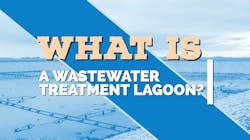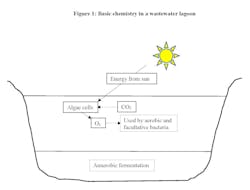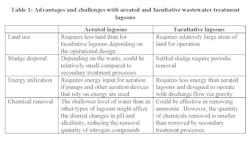A wastewater treatment lagoon is an earthen pond where wastewater is treated via natural and biochemical processes. They are used by some rural communities due to their lower maintenance requirements and higher energy efficiency compared to other wastewater treatment options.
Wastewater treatment lagoons are also used by industrial and commercial facilities as a component of their wastewater treatment facilities. The EPA identified a total of 4,657 discharging lagoon systems in 2022 of which 83% were identified as publicly owned treatment works. These lagoon systems (84%) serve small communities comprising less than 3,000 people.
Types of lagoons: Aerated and facultative
Wastewater treatment lagoons could be aerated or anaerobic lagoons depending on the type of wastes they are designed to treat.
Anaerobic lagoons mostly treat animal wastes from farms. However, aerobic lagoons are more common and they could be fully aerated or partially aerated (also known as facultative lagoons). Facultative lagoons are used for treating low to medium strength wastewater from municipal and industrial sources.
Both aerated and facultative lagoons contain algae which are essential for treating the wastewater in the lagoon.
Oxygen levels in aerated and facultative lagoons
The top layer contains dissolved oxygen in both aerated and facultative lagoons. The latter also contains an intermediate anoxic layer where the oxygen level varies from the highest level at the top to an anerobic zone at the bottom.
The oxygen in aerated lagoons could be controlled technically by mechanical technologies. Naturally, it depends on seasonal factors including temperature.
How does a wastewater treatment lagoon work?
In aerobic and facultative lagoons, algae cells in the top layer utilize the sun’s energy and carbon dioxide (CO2) from the water to undergo photosynthesis and produce oxygen used by aerobic and facultative bacteria to treat the chemicals in the wastewater. This is illustrated in Figure 1.
The level of the oxygen and also the pH (due to CO2 utilization) could fluctuate in the surface water. During sunny and warm days, the oxygen level in the surface water and also possibly the pH is higher than it is at night. The high pH level allows for ammonia removal via volatilization.
Anaerobic fermentation occurs in the bottom layer of deep lagoons. The anaerobic fermentation rates could be significantly reduced in cold weather resulting in slower wastewater treatment.
Why use a wastewater lagoon for treatment?
It is a simple way to treat wastewater from municipal, commercial, and industrial discharges.
Aerated lagoons require less land than facultative lagoons and depending on the operational design, could employ aeration devices to remove total suspended solids, ammonia, and phosphorus (Table 1).
Facultative lagoons, while they require less energy to operate than aerated lagoons, could remove a significant amount of ammonia depending on the temperature, pH, and detention time of the effluent discharge in the lagoon. While the chemical removal efficiency is lower in the winter for facultative lagoons, approximately 50% removal has been reported due to precipitation reaction occurring in high pH conditions.
Associations between lagoons, septic systems and treatment plants
Wastewater effluent discharge could flow from a septic tank to a lagoon and from a wastewater treatment plant to a lagoon. This association depends on the type of lagoon and the wastewater treatment facilities.
Residential sewage lagoons
Residential sewage lagoons in central and west Oklahoma receive effluent discharges from septic tanks. Wastewater from residential areas enter the septic tank where sludge from the wastewater settles at the bottom. The wastewater flows from the septic tank into the lagoon where it receives treatment depending on the chemical and physical factors including sunlight, temperature, and wind. This wastewater treatment system uses gravity for wastewater flow from the sources to the septic tanks and to the lagoons.
There are state regulations for residential on-site wastewater treatment lagoons. For example, the Nebraska Department of Environmental Quality includes specifications for the location and design. The Kentucky General Assembly for on-site sewage disposal systems includes the size requirements for evaporation-absorption lagoons.
The discharge of wastewater from the lagoon depends on the state regulations. For example in Nebraska, there is no outlet and evaporation occurs in residential on-site wastewater lagoons.
Wastewater treatment plants and lagoons
In the City of Troutdale, Oregon, the wastewater is treated in a wastewater treatment plant facility before it is discharged to a lagoon approximately 560 feet long, 225 feet wide, and 7.5 feet deep. The settled solid from this lagoon is then transported for land-based applications to agricultural fields in compliance with the regulations by the Oregon Department of Environmental Quality.
The treatment of the wastewater in the lagoon depends on state regulations. In the Town of Davie, Florida, the wastewater is pumped to wastewater treatment units and is treated prior to entering the lagoon basins. It is disinfected in the lagoons before used for irrigation.
Do sewage lagoons smell?
They could emit an odor seasonally due to the decomposition of biological components and the underlying chemical reactions including from the removal of nitrogen compounds.
Strong odors could be a sign of lagoon system failure, overloading, or both. However, odor control is included in some state regulations for lagoon maintenance.
How do you maintain a sewage lagoon?
State regulations for residential on-site sewage lagoon systems that include septic tanks require septic tank maintenance. Depending on the tank size and sewage volume, the septic tank should be pumped out periodically not only to prevent overflow and to allow for the treatment processes to continue normally, but also for odor control. Also, some state regulations do not allow planting vegetations around lagoons.
State regulations for lagoon maintenance are available online. Examples include the lagoon wastewater treatment manual by the Montana Department of Environmental Quality.
The U.S. EPA Action Plan for lagoons
In addition to state regulations, the U.S. EPA has a lagoon wastewater treatment action plan for 2022-2026. The goals of this plan is to provide equitable and accessible technical and financial assistance to rural and tribal communities that rely on lagoon wastewater treatment systems.
Besides providing the tools to underserved communities to achieve this, the five priority areas also include identifying the nationwide universe of lagoon wastewater treatment systems, developing cost and performance data for technologies to treat ammonia and nutrients in these wastewater systems, tools to support regulations, and plans to engage the community in this action plan.
While lagoon wastewater treatment systems can provide effective wastewater treatment, they also have challenges in seeking the funds to invest in infrastructure to achieve improvements in water quality. And the EPA’s lagoon action plan does just this and much more as mentioned above to support communities that use lagoons for wastewater treatment.
About the Author
Saleha Kuzniewski
Saleha Kuzniewski, Ph.D. has authored several publications in the fields of scientific research, biotechnology, and environmental regulations. She is the winner of the 2023 Apex award for publication excellence. She is also the founder of Environmental Remediation & Innovations, LLC. Kuzniewski can be reached at [email protected].



